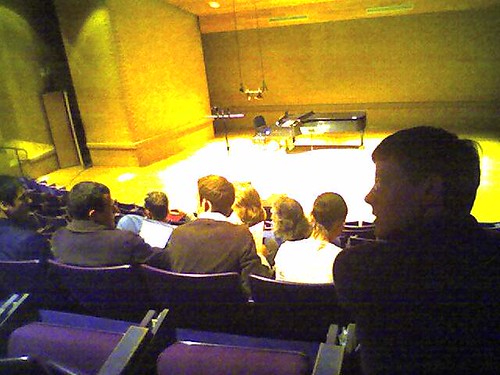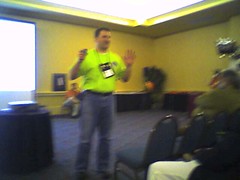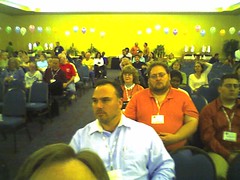[Originally posted on the Technology & Learning Blog — March 20, 2006]
One of the most interesting topics being discussed at education technology conferences today is the instructional potential of video games. Much of this has come from talks and writings by Marc Prensky (Digital Natives, Digital Immigrants), but many others from MIT, Harvard School of Education, and other people and places. So what is it about video games that compel students to learn, and might we leaverage it in our classrooms?
 I wrote recently about cultivating classrooms into learning engines, and it occurred to me, that there may be some correlations between this notion of a classroom as learning engine and the game engines that drive video games. So upon discovering a vocabulary list of video game terms in the Januar 2006 issue of MacAddict, and with the permission the magazine’s publisher, Bernie Lanigan, I am including that glossary here, with some comments on how these terms might apply to a well crafted classroom learning environment.
I wrote recently about cultivating classrooms into learning engines, and it occurred to me, that there may be some correlations between this notion of a classroom as learning engine and the game engines that drive video games. So upon discovering a vocabulary list of video game terms in the Januar 2006 issue of MacAddict, and with the permission the magazine’s publisher, Bernie Lanigan, I am including that glossary here, with some comments on how these terms might apply to a well crafted classroom learning environment.
The Gamer’s Glossary*
Boss — A unique, especially difficult enemy that typically appears at the end of a level. Look for an obvious, terrible flaw destined to be its undoing, such as an exposed, flashing heart.
So when students see someone acting like the boss, do they see guidance or do they see a barrier? I suspect that teachers should try not to be the boss, and instead, as John Beck says **“..be the strategy guide.” The strategy guide is a booklet that game players for the shortcuts and cheats. If we can devise a place that students want to get to or something that they want to be, then teachers can become the strategy guide with the shortcuts for getting there — the shortcuts being the curriculum.
BOT — A character normally controlled by a human that is instead controlled by the game’s AI. Usually found in an online First Person Shooter.
Of course, there is no artificial intelligence in the classroom. However, there are characters from history, and perhaps even made up entities, who can be inserted, talked about, and even dressed in circumstances that will help students learn what they are supposed to learn. We teach by example, and the bot, is that example. But the example must be rich and lifelike. It must be more than a story or a spoken description. It must come from life-giving media-rich sources.
Engine — The fundamental algorithms and routines that serve as a game’s technical backbone. Particularly robust engines are often licensed by other game developers to save time.
These are the practices and procedures of the classroom. The game engine enables and empowers activities that are compelling and empowering to the player. How might we adapt what we expect students to do, that empowers them…puts the game controller of learning into their hands. The engine both empowers, and it sets limits. In the game environment, even the limits are designed to excite and challenge.
HP — Hit points. How much damage a game character can take before dying.
We don’t want anyone to die. But, traditionally, students start with zero, and they try to work their way to 100%. Why not start at a place of value and pride, and allow them to build on it, but also lose from it, Hit Points. But the hits do not embarrass. Instead, they challenge the student.
Level — 1: A subsection of a game, often with a distinct graphical theme (a jungle, for example, or cave), that has a definite beginning and end. 2: A numeric indicator of your power, often increased as you accumulate experience points. When your level increases by one, this is called “leveling up.”
The idea of levels is not new to education. However, ones level has more to do with their age than their achievement in the game. Why not figure out a way to institute levels within a classroom, making level positions highly mobile, almost daily.
Mana — Generic term for your supply of magic power, which is usually depleted as you cast spells or use special abilities.
This might be the most difficult aspect of game play to relate to classrooms. It may also be the most interesting. So what is the magic that takes place in the classroom. What is the mana. Some possibilities are information, questions, access to information technology, access to specific software, access to team members, time in the library, time in a workshop. What empowers students?
MOB — A monster, usually in an MMORPG (Massively multiplayer online role-playing game). Short for mobile, a term used in early online text RPGs to describe a creature that had the then-astounding ability to move from room to room.
A monster than can surprise you? This one is easy — the pop-quiz. However, perhaps we can rethink the way that we apply the pop-quiz, so that it is more of a challenge that students have to get through, in order to achieve their goal.
NPC — Non-player character. Any enemy, ally, townsperson, or other entity that a human player does not control.
This is a context for learning. What is the world in which these things are true and why it is important to know them. The difference is in the richness. NPCs in a video game are difficult to distinguish from human controlled players. They are visual, colorful, they move and interact with the environment. They are nearly real. How do we present context to our students in a way that is nearly real? By making it rich and something that we can interact with.
PC — Player character. Any character in a game that is countrolled by you or another human.
Classmates are player characters. However, a PC is only relevant if we can interact with them and see their interactions with the game world. If students, as part of the classroom practices and procedures, are interacting with each other, in a way that results in learning and building of ideas, then they become more active themselves — more active learners. It is also important to note that many game environments are economies, where power and currency are traded. Think about it.
Power-Up — an item (like Mario’s mushroom) that increases your power when collected, usually until you die or a timer expires.
In what kind of assignment might a book, web site, piece of software, manipulative, or other instructional material be seen as increasing the learners power. The key is not in the object, it’s in the environment that responds to the object, that responds to knowledge and skill.
XP — Experience points. Earned by defeating enemies; used to permanently increase your powers and abilities.
This one is easy. It’s grades. But XPs “…increase your powers and abilities.” Grades merely symbolize them. What are the powers and abilities that might bestow themselves onto students, as a result of defeating the barriers of learning.
This certainly is not a full treatment of how a classroom might facilitate better learning by acting like a video game. It may be a ridiculous notion. But we are discovering that students do learn in video games, and they learn valuable higher order thinking skills. I believe that we need to be looking for the crossover between video games and our classrooms, and paying attention to those who are engaged in this task.
Here are some search resources that might help:
* Molloy, Sean. “The Gamer’s Glossary.” MacAddict Jan 2006: 38-39.
** Beck, John. Personal interview. 15 2005.
 When you are on the road, you can not avoid CNN. It’s in the Airport. CNN, and its ilk, comprise at least 80% of the TV channels in most hotels (trying to get you to resort to their $12 movies on demand).
When you are on the road, you can not avoid CNN. It’s in the Airport. CNN, and its ilk, comprise at least 80% of the TV channels in most hotels (trying to get you to resort to their $12 movies on demand).
 At the airport in Raleigh, yesterday, I received an e-mail from Steve Dembo, describing how he had read the April issue of WIRED Magazine on the train. He suggested that we hold a roundtable discussion about the influences of video games in education — but that we hold the meeting inside of
At the airport in Raleigh, yesterday, I received an e-mail from Steve Dembo, describing how he had read the April issue of WIRED Magazine on the train. He suggested that we hold a roundtable discussion about the influences of video games in education — but that we hold the meeting inside of  In the April issue of WIRED Magazine, Will Wright, the inventor of The SIMS, heads off an interesting series of pieces on the impact and direction of video games. In his introductory article, Dream Machines, Wright says,
In the April issue of WIRED Magazine, Will Wright, the inventor of The SIMS, heads off an interesting series of pieces on the impact and direction of video games. In his introductory article, Dream Machines, Wright says,
 I wrote recently about cultivating classrooms into learning engines, and it occurred to me, that there may be some correlations between this notion of a classroom as learning engine and the game engines that drive video games. So upon discovering a vocabulary list of video game terms in the Januar 2006 issue of MacAddict, and with the permission the magazine’s publisher, Bernie Lanigan, I am including that glossary here, with some comments on how these terms might apply to a well crafted classroom learning environment.
I wrote recently about cultivating classrooms into learning engines, and it occurred to me, that there may be some correlations between this notion of a classroom as learning engine and the game engines that drive video games. So upon discovering a vocabulary list of video game terms in the Januar 2006 issue of MacAddict, and with the permission the magazine’s publisher, Bernie Lanigan, I am including that glossary here, with some comments on how these terms might apply to a well crafted classroom learning environment.
 I am finishing up Frank McCourt’s (author of
I am finishing up Frank McCourt’s (author of 
